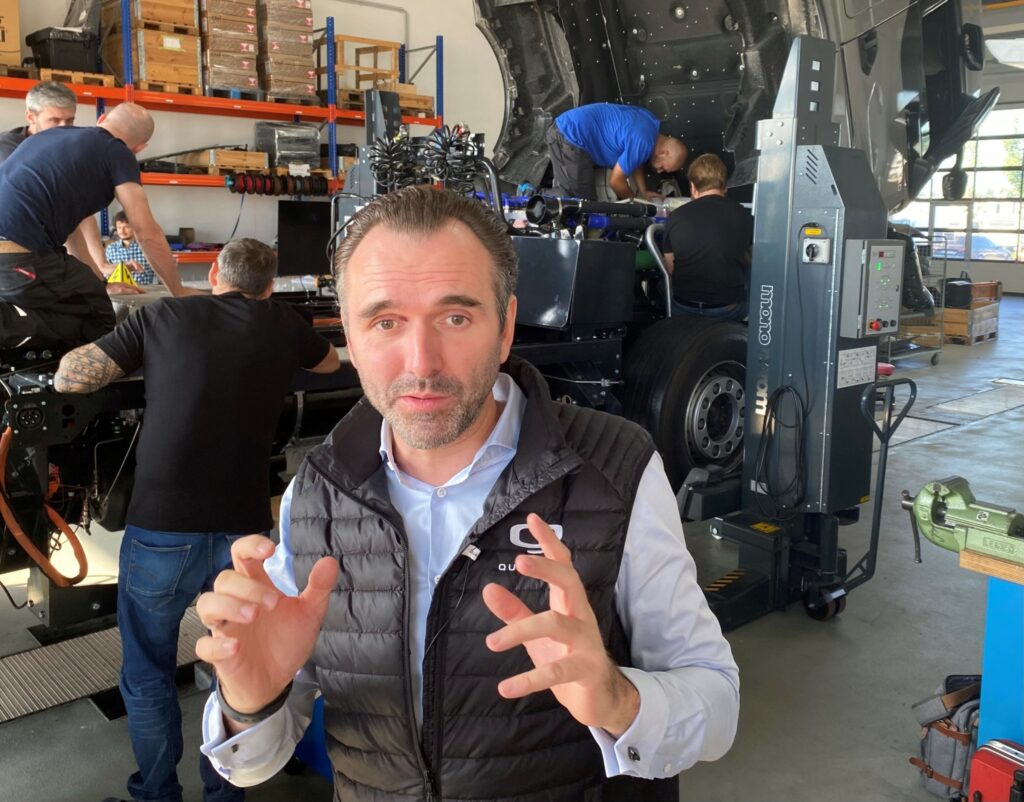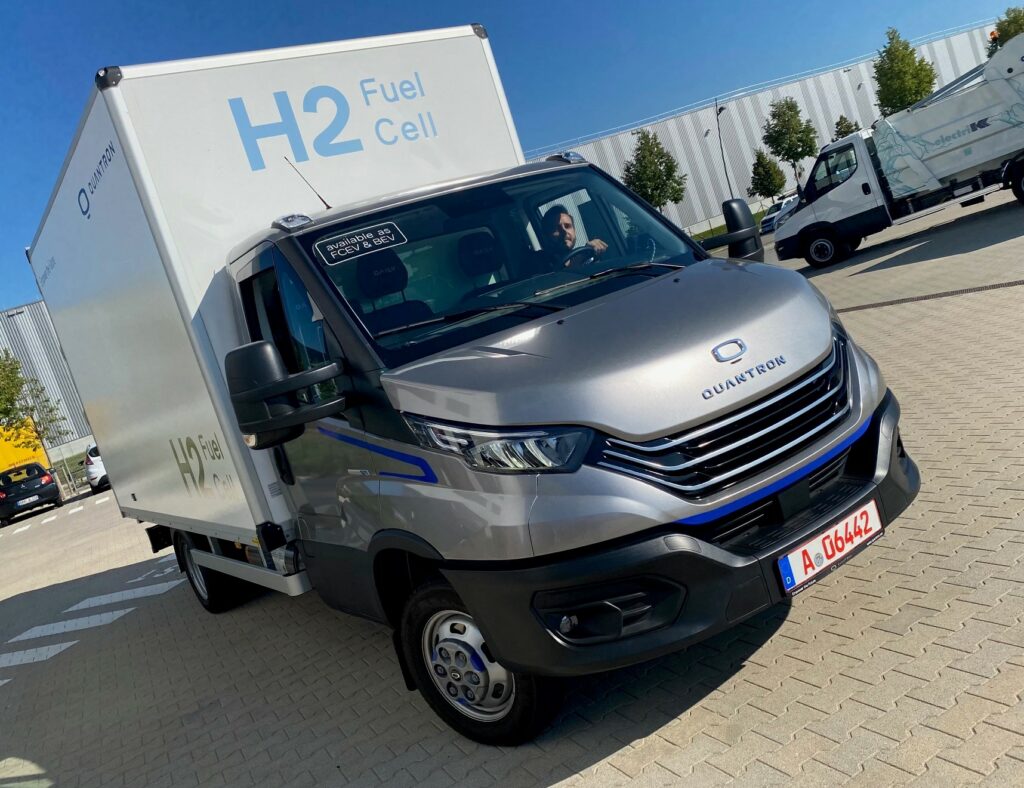Quantron gears up to become “range leader” in North America’s ZEV market
Germany-based Quantron has set its sights on becoming the range leader for zero-emissions trucks in the North American market and is developing a Class 8 hydrogen-fuel-cell-electric vehicle to help achieve that goal.
Richard Ansell, vice-president of marketing for Quantron U.S., gave journalists (visiting the company’s Augsburg, Germany headquarters as part of a House of Journalists site visit) some insights into the company’s ambitious plans for the North American market.

“Our whole strategy in the U.S. is focusing on fuel cell technology in the Class 8 segment,” he said. “Our goal is to be the range leader.”
Quantron has secured a supply deal with Canada’s Ballard Power to supply fuel cells and is in talks with North American truck makers to secure gliders that will serve as the chassis. But chief technical officer Rene Wollmann admits those discussions are ongoing due to the strong market that currently exists for finished — and more profitable — vehicles.
“They are now at peak demand. They don’t want to sell you gliders, but we’ve had a couple of initial conversations with OEMs and I think one or two we are going to take forward because we want to deliver a longnose truck,” he said.
Ansell said the company’s initial design will accommodate 80 kg of on-board hydrogen storage, enough for 750 miles (1,200 km) of range. But, he added, “We have line of sight for getting to 120 kg.” That would provide 1,000 miles (1,600 km) of range when fully loaded.
The company is also examining the possibility of storing liquid hydrogen on-board the trucks — potentially extending range to the point where, stopping only twice for fuel, they could travel from Miami to Los Angeles. It’s the long range and fueling times similar to diesel that have Quantron convinced fuel-cell-electric trucks are the answer for zero-emissions longhaul transport in North America.
The company has big plans for the market. It has a 30,000 sq.-ft. facility in Auburn Hills, Mich., where it will be able to build up to 1,000 trucks a year. There’s also a “framework agreement” with an unnamed logistics company interested in taking 500 trucks, and conversations with other fleets. Ansell said the company plans to begin producing trucks at the Michigan plant in the first or second quarter of 2024.
It has partnered with FirstElement Fuel to build hydrogen fueling stations, too. And Ansell said the company also sees Canada as an ideal place to deploy its trucks.

“Canada seems to be even a bit further along [than the U.S.] in terms of infrastructure,” he said, noting the company has had discussions with companies in Quebec where an abundance of cheap hydro can provide low-cost hydrogen production. “There is a big opportunity up there for us.”
Quantron may be new to North America, but it already has battery-electric and fuel-cell-electric trucks in production in Europe. These include a Class 3/4 QLI FCEV powered by Ballard’s FCmove-MD fuel cell, with a 450-km range, eight kilograms of on-board hydrogen storage, and a 37-kWh high-voltage battery.
The fuel cells are packaged within the frame rails, leaving the back of the cab clear. The truck can be fueled in about five minutes.
The QHM FCEV Aero is the company’s European heavy-duty offering, which is in pre-series production, with a range of 700-1,500 km (depending on whether it’s equipped with 54- or 116-kg capacity hydrogen tanks). It can be fueled in 15 minutes and is available in several offerings including 4×2 and 6×2 tractor and chassis configurations. The heavy-duty truck is powered by Ballard’s FCmove-XD fuel cells.
And like its smaller sibling, the tanks on the 54-kg version are mounted entirely within the frame rails, staying within European length requirements without sacrificing sleeper space.
Mounting the tanks to the back of the cab in a so-called “backpack” configuration requires European fleets to seek special exemptions, pull shorter trailers, or spec’ trucks with smaller sleepers. Some countries, such as Norway, offer a one-meter length exemption for zero-emissions vehicles, which is how Quantron can produce a 116-kg version with hydrogen tanks mounted both within the frame rails and on the back of the cab. North American regulations will also allow such a configuration, greatly increasing range.
Quantron is looking beyond the battery and fuel cells to maximize range, however, also focusing on aerodynamics, optimizing torque demand, electric powertrain and fuel cell programming, overall weight, and even tire rolling resistance. Wollmann said such efforts produced a 20% drag reduction on its European heavy-duty truck, increasing range by 10%.
Its fuel-cell-electric trucks fitted with 54-kg tanks weigh the same as diesel trucks, so there are no payload sacrifices to speak of, compared to the 13,000 to 15,000-lb. of batteries required on heavy-duty battery-electric trucks.
But Michael Perschke, CEO of Quantron, acknowledged fuel-cell-electric trucks still have a way to go to achieve total cost of operation parity with diesel. He anticipates this occurring as early as 2026, as truck production costs drop along with the cost of green hydrogen, and diesel prices rise with increasing emissions-related taxes.
FirstElement Fuel was chosen as Quantron’s hydrogen fueling station partner as it is the market leader in the U.S, with 80% market share in California. The company has already dispensed about 6 million kilograms of hydrogen through 2.1 million fills. It has built 40 hydrogen stations, according to founder and CEO Shane Stephens.
The Truck Zero-branded stations can typically provide about 1,500 kg of hydrogen a day and FirstElement is opening its first commercial-scale heavy-duty truck fueling station at the Port of Oakland later this year, capable of providing 15,000 kg of hydrogen per day – enough to keep 150-200 trucks running.
Stephens said this station will be the first in the world capable of refueling trucks with up to 80 kg of hydrogen storage in less than 10 minutes.
Have your say
This is a moderated forum. Comments will no longer be published unless they are accompanied by a first and last name and a verifiable email address. (Today's Trucking will not publish or share the email address.) Profane language and content deemed to be libelous, racist, or threatening in nature will not be published under any circumstances.